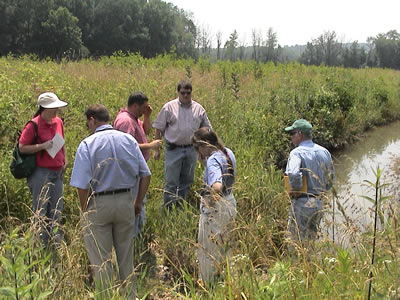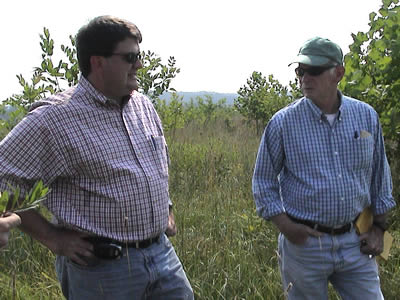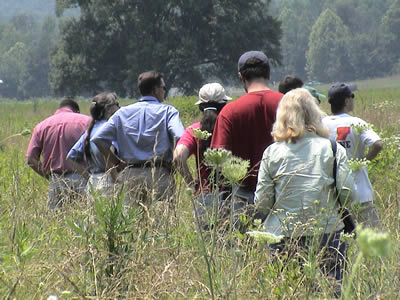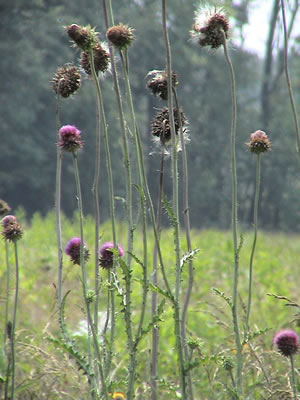Kentucky

Lee Andrews, USFWS (center), introduces a new wetland and
stream mitigation site he recently helped acquire for KYTC. The
60-acre site includes 3,700 linear feet of stream. The site will
be owned and managed in perpetuity by the Southern
Conservation Corporation.
Program Contacts
John Dovak
Kentucky Transportation Cabinet
200 Mero Street
Frankfort, KY 40622
Phone: 502-564-7250, Fax:502-564-9540
Email: John.Dovak@ky.gov
Anthony Goodman
Environmental Specialist
FHWA-Kentucky Division
330 West Broadway, Room 264
Frankfort, KY 40601
Phone: 502-223-6742, Fax: 502-223-6735
Anthony.Goodman@fhwa.dot.gov
Program History and Philosophy
More than one-half of Kentucky's original wetlands have been lost primarily as conversion to cropland and pastureland; most conversions have been in western Kentucky. Today, wetlands compose less than 2.5 percent of Kentucky's land area, but they have considerable environmental, socioeconomic, and aesthetic value. Most Kentucky wetlands lie shoreward of rivers, lakes, and reservoirs, and include cypress swamps, bottomland hardwood forests, marshes, and ponds. (9)
Most of Kentucky's wetlands are privately owned. The State fosters protection of wetlands through a system of registry and dedication agreements with private individuals and other private entities. In the early 1990s, implementation of mitigation did not meet agency expectations. In 1998 an in lieu fee program was established to improve the performance of mitigation projects. That program has seen limited success in implementing mitigation projects due to difficulty in obtaining suitable sites.
A few entrepreneurial banks exist in Kentucky under the oversight of an MBRT, but credit costs have been problematic for the Kentucky Transportation Cabinet (KYTC). As a result, KYTC sought to establish a separate umbrella banking agreement with several agencies to lay out an administrative process for its own mitigation banking initiative. Some of KYTC's mitigation sites were already 10 years old. Because land costs have been rising quickly in recent years, the cabinet was interested in buying additional sites for advance mitigation before the land costs became prohibitive. Attempts to draft a banking agreement, however, became paralyzed by what-if scenarios and contingency planning.
In 2004 KYTC forged a memorandum of agreement with USFWS and FHWA to launch the KYTC Stream and Wetland Mitigation Program. Like Texas DOT, North Carolina DOT and Minnesota DOT, KYTC has opted to use a third party (in this case, USFWS) to coordinate its consolidated mitigation activities. In addition to expediting the 404/401 permitting process, this approach has proven especially beneficial to KYTC in three regards: USFWS can (1) find potential mitigation bank sites faster than KYTC, (2) quickly draft site proposals and implementation plans that meet regulatory standards, and (3) leverage additional funding and negotiate real estate transactions effectively with land trusts, conservation organizations, and private landowners. USFWS gains certain benefits as well - most importantly, the opportunity to use funding from KYTC to support high quality conservation projects where the perpetual protection and management of vital waters and species is provided in exchange for any mitigation and/or conservation credits that may result.

USFWS’ Lee Andrews (left) discusses the KYTC/USFWS MOA with
scan team leader and FHWA senior ecologist Paul Garrett (right).
In place of a banking agreement, KYTC establishes its mitigation sites using a consolidated approach, similar to Ohio DOT. Mitigation for several projects is developed using funding from a single project. Nationwide Permit (NWP) 27 is typically used, although this is not ideal as the NWP 27 expires after five years, and KYTC will need to reapply at that time. Moreover, what typically has been a six-month application process is now turning into 12 to 15 months due to agency discussions over how best to mitigate for unavoidable stream impacts. To help prepare for the challenges the cabinet foresees with stream mitigation, KYTC is working with the University of Kentucky and FHWA to implement mitigation principles adopted by the cabinet for highway project-related stream impacts.
The 2004 MOA between KYTC and USFWS is a significant step forward for the cabinet's mitigation program. The agreement is supported by all of the State's four COE districts. It is anticipated the agreement will greatly facilitate inter-agency discussions regarding the adoption of a functional assessment methodology, particularly for stream mitigation, and help secure mitigation credits more reliably.
Since the enactment of a provision by the Kentucky State Legislature requiring the spending down of all transportation surplus funds, KYTC has been unable to use State funds to purchase land for advance mitigation. For the short term, it is using funds from one transportation project budget to pay for consolidated mitigation required for several projects. Further, while KYTC has been aware of the fact that TEA-21 made funding available for advance mitigation, the process for how to access and utilize those Federal funds has been unclear to the cabinet's financial and legal personnel who cannot find a mechanism for fronting the costs of land purchases and bank credits until Federal reimbursements are received. Current policy is that no reimbursement can be made until actual construction of mitigation occurs. Current budgets do not include a large account for such expenditures. Such accounts can only be established within the program approved by the State Legislature. Since the Kentucky State Legislature only meets every two years, any new funding proposal would inevitably require a three-year implementation phase. As a result, funding advance mitigation remains an ongoing problem for KYTC, and the cabinet is eager to receive additional Federal guidance on how to approach this issue.
Site Descriptions and Operations

Scan team tours the Exel Clark wetland and stream mitigation site.
KYTC has purchased a total of eight properties for wetland mitigation of highway project impacts. Several more are being considered for purchase using the new MOA with USFWS. The properties, most of which have been acquired as fee-simple real estate, are located throughout the State, with the overall goal of establishing at least one bank in each major watershed.
The cabinet prefers to purchase and restore prior converted croplands for its program. These offer a greater chance of success compared to created wetlands, which historically have functioned poorly in Kentucky. KYTC will not consider mitigation sites on coal mining lands due to mineral rights issues.
KYTC's mitigation sites range in size from 60 to 350 acres. Transportation projects impact an average of 20 acres of wetlands per year. KYTC estimates that it spends approximately $5,000/acre for wetland restoration ($100 to $300/linear foot for stream restoration).
The following mitigation sites were visited on the scan tour:
- Nelson County Mitigation Site (350 acres; 65 acres restored)
Located in the Salt River watershed, this site involves the restoration of 65 acres of bottomland hardwood forest habitat on prior converted croplands. Restoration objectives include improving wetland habitat diversity, improving habitat connectivity, and improving wetland functions, including water quality functions, such as increased nutrient and sediment absorption and assimilation.
- Exel Clark Mitigation Site (60 acres w/3,700 linear feet of stream)
This site will be utilized though the new MOA with the USFWS. Located in the Lower Green River watershed within the Muddy Creek basin, this site involves the restoration of bottomland hardwood forest habitat on prior converted croplands. The COE has verified nine acres of emergent wetlands on site that will be enhanced, and any other wetlands that occur at the end of the monitoring period would be counted as restored wetlands. Stream mitigation credits will be determined based on pre- and post-project functional assessment. The Southern Conservation Corporation is the owner and perpetual manager of the site.
Geographic Service Areas. The wetland bank service areas correspond to Kentucky's major watersheds. HUC-6 and HUC-8 service areas apply for some of the sites. Approval for larger service areas can be granted at the discretion of the MBRT.
Functional Assessment Methodology. Wetland mitigation acreage is based on level of wetland functions. The minimum mitigation ratio is 2:1. Preservation is 10:1. Hydrologic and vegetative criteria must be demonstrated for five years, per the specifications of the individual site plan, before credits can be released.

Musk thistles are a common invasive plant in
Kentucky in need of control.
Monitoring Protocols. A monitoring report is provided annually to the regulatory agencies and includes the following: summary of hydrologic monitoring for previous year (unless hydrologic success criteria have been met previously); analysis of hydrologic monitoring that compares the results to the site's restoration goals and the hydrologic success criteria; graphs of the surface and subsurface water elevation data for all monitoring wells; summary of vegetative monitoring for previous year (unless success criteria have been previously met); analysis of vegetative monitoring; statement as to whether or not the hydrologic and/or vegetative success criteria were met for the annual monitoring period, and if not met, an analysis of the corrective measures or improvements proposed; and at least four representative photographs of vegetative monitoring plots.
Accounting Procedures. KYTC, as 404 permittee for all wetland impacts due to highway construction in Kentucky, is responsible for maintaining an accounting log of all wetland credits generated and utilized for each wetland bank it operates. This information is submitted to the COE and Division of Water annually or upon request.
Maintenance and Management. In accordance with the new MOA, the USFWS and its partner (e.g., Southern Conservation Corporation, The Nature Conservancy, etc.) assumes responsibility for implementing the wetland mitigation plans and any necessary corrective measures or improvements required on the site. KYTC, however, is still in discussions with USFWS and the cabinet's financial officers about provisions that should be added to the mitigation plans to ensure proper care of the properties over the long term. As the permittee, KYTC remains accountable to the COE for all activities associated with the site. Therefore, KYTC is considering incorporating the following contract provisions: pay-as-you-go mitigation (i.e., pay only for services successfully rendered), performance bonding, and reversionary clauses.
Best Practices and Innovations
- The USFWS is tasked with finding potential mitigation sites. The use of USFWS to recommend mitigation expedites permitting for three reasons:
- USFWS can identify the sites faster than KYTC.
- USFWS can quickly draft proposals and implementation plans that satisfy regulatory requirements. Since USFWS is one of the chief agencies that evaluate mitigation plans, it is expeditious to have the agency that is knowledgeable of the resource needs actually develop the mitigation proposal.
- USFWS, being recognized as an agency charged with protecting wildlife, can often leverage additional funding and negotiate real estate transactions more effectively with land trusts, conservation organizations, and private landowners.
- USFWS has a vested interest in the success of mitigation.
- Site selection is a primary role of USFWS' involvement.
- USFWS' involvement directs mitigation efforts toward resource needs and the agency's own species recovery goals.
- Geographic service areas are flexible and correspond to Kentucky's major watersheds. While some sites are limited to HUC-8 or HUC-6 areas, larger service areas can be granted at the discretion of the MBRT.
- The mitigation ratio is based on wetland function, with impacts to high quality wetlands requiring a higher mitigation ratio.
- Preservation is allowed as mitigation with a ratio of 10:1.
- USFWS, or other entity acting as owner of the mitigation property (e.g., Southern Conservation Commission, The Nature Conservancy, etc.), assumes responsibility for implementing the wetland mitigation and corrective measures or improvements required on site, with funding provided by the KYTC.
Continuing Challenges
- DOT financial personnel need to be in the communication loop on how to administer cost-reimbursable expenses for advance mitigation with Federal dollars.
- Mitigation that involves stream restoration suffers from a significantly slower permit processing time. The process has gone from an average of 6 months to approximately 12 to 15 months because of the uncertainty of mitigation for stream restoration.
- Funding for long-term stewardship of the mitigation areas is an ongoing issue.
- Neither USFWS nor KYTC wants to own mitigation properties. Long-term property ownership issues must be resolved.
Back to top

